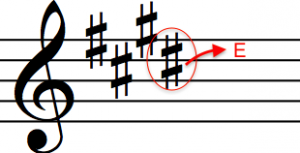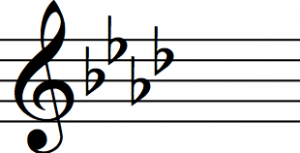Are you pulling out whatever hair you have trying to understand and read key signatures? Here’s a brief tutorial to help you know how to identify them! They are key to music, after all… (bad pun hyuk, hyuk)
NOTE: In this tutorial, I’m assuming you’ve learned to identify all of your lines and spaces on the grand staff. If you haven’t yet, see this tutorial for all the “cheater aids” that I love to help my students learn these. This knowledge is foundational, so do the work and memorize the lines and spaces for both treble and bass clef.
All right, let’s proceed. Get your sheet music out for the piece that’s giving you fits knowing what key it’s in. Scan the piece looking for the starting key signature and any other key signatures that may be contained within the piece, for example.
First, identify any sharps or flats in the key signature at the beginning of the piece. Note that your key signature will have either sharps or flats, not both. Remember that there may be a key change mid-piece, so look for those, too, and make note of them.
Second, identify the order of the sharps or flats. This order will help you find the scale’s “name.”
When working with a key signature containing sharps, look at the sharp that is farthest to the right of the group of sharps. The key is the note that is one half-step above that sharp. Example:
Now you try it. Can you figure out what this key below is? (Scroll down to bottom for answer.)
When working with a key signature containing flats, find the second-t0-last flat on the right and that letter name is the key. Example:
That’s the key of E-flat.
Note that in all cases but one (the key of F) for key signatures containing flats, you have to say the “flat” with the letter name in order to signify the correct key – “E” is not the same as “E-flat.”
Aren’t there always exceptions to every rule in life? Here’s one. The exception to the whole “X-flat” thing is the key of F, which has only one flat, which has two exceptions. 1st exception: there are no flats that are “second-to-the-right.” Just memorize the fact that the key with one flat is the key of F (not F-flat; just F). 2nd exception: it’s the key of F not F-flat.
Now you try it. What key is this?
Again, scroll down for the answer.
Has this tutorial helped you? It helps me when you comment below and provide me with feedback. Also let me know, What gives you fits when it comes to reading music?
Bonus: Circle of Fifths
Here’s a handy dandy chart called the Circle of Fifths that will help you quickly and easily identify the key signatures:
For those of you already familiar with the Circle of Fifths, you’ve already noticed that I’ve blotted out the minor keys. I did that so folks just beginning won’t be confused. That’ll be covered in another tutorial.
Answers:
Key: G
Key: A-flat





1 Comment
Harpal sandhu · June 16, 2019 at 3:20 PM
Great instruction and methodology
Pl help and guide
Looking for music melody and harmony score analysis of songs .matching notes with syllables and rhythm so speed up learning .
harpal harpaulsandhu@gmail.com
Comments are closed.